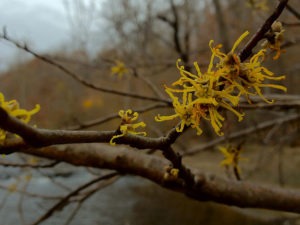It’s the time of year when almost everything has stopped blooming. If I look hard enough, I might be able to find a few clover, dandelion, or smartweed blossoms left. The crazy cold, then warm weather has also tricked our lilac into putting out a few blooms. However, for the most part, the flowering season is over for the year – except for witch hazel.

American witch hazel (Hamamelis virginiana) is a large shrub or small tree that is native to the eastern U.S. It is found in moist, semi-open woods. Unlike most flowering plants, it starts blooming in the late fall – usually mid to late October in Kentucky. It has bright yellow flowers with long, thin petals. Witch hazel will often continue blooming for several weeks. When the weather turns cold or frost threatens, the petals will curl up to form a protective covering over the rest of the flower.
Witch hazel’s late fall blooming provides pollinators with some of their last opportunities to feed before winter. The shrub’s yellow flowers produce pollen and nectar and is primarily pollinated by small flies and bees. However, witch hazel’s late fall blooming period comes with a significant risk. If the weather is too cold or wet while it is blooming, then its pollinators will be unable to fly. The fertilization rate for witch hazel, therefore, tends to be much lower than for many other plants that bloom earlier in the season.
Once a witch hazel flower is pollinated, the flower essentially hits the “pause” button on development. The seed won’t start developing until spring. It takes a full year for witch hazel seeds to develop and disperse. After being dormant all winter, they begin developing in the spring. The ripe seed pod turns brown and begins to dry out. Eventually, the seed pod will pop open and propel the small, dark seeds up to 30 or 40 feet away from the mother plant. The seeds are usually ejected around the same time as the plant is flowering. The presence of both flowers and ripe seed pods is another unique characteristic of witch hazel compared to other native shrubs and trees.
Witch hazel can be grown as a native ornamental shrub or tree. In addition to American witch hazel (H. virginiana), there are four other species of witch hazel. Two of those species are native to the U.S., but not to Kentucky. One of the remaining species is native to China and the other is native to Japan. There are also several cultivars of witch hazel that are primarily results of hybridizing the Chinese and Japanese species. However, American witch hazel is the only one that blooms in the late fall; the others bloom in late winter to early spring. If you are considering planting witch hazel, I suggest planting our native witch hazel to take advantage of its cheery yellow blooms and to give our pollinators one last feeding opportunity at a time when little else is blooming.

This article was part of Shannon’s original Kentucky Pollinators and Backyard Wildlife blog which evolved into the blog for Backyard Ecology.

Backyard Ecology: Exploring Nature in Your Backyard
Nature isn’t just “out there.” It’s all around us, including right outside our doors. Hi, my name is Shannon Trimboli, and I am the host of Backyard Ecology. I live in southcentral Kentucky and am a wildlife biologist, educator, author, beekeeper, and owner of a nursery specializing in plants for pollinators and wildlife conservation. I invite you to join me as we ignite our curiosity and natural wonder, explore our yards and communities, and improve our local pollinator and wildlife habitat. Learn more or subscribe to my email list at www.backyardecology.net.

Leave a Reply